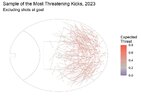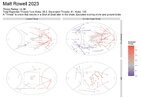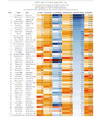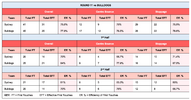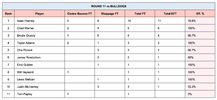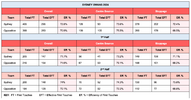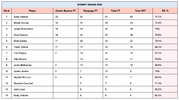I wondered if the stat reflects how we use the player, rather than how good or bad they are?
That’ll definitely be a part of it, since it’s weighted with what you’d expect from the average player taking that same kick.
So a player that is used to take conservative outlet kicks in the d50, and hits them at about the average rate would have threat and retention ratings of about 0.
Conversely, a player that is used to deliver the ball inside 50, and finds a dangerous target at about the average rate for that kick, would also have a threat and retention rating of about 0.
So it’s also useful to look at the xThreat/kick and xRetention/kick columns.
Generally defenders will be taking kicks with lower xThreat and higher xRetention values.
And you’ll see in the 2nd chart, for instances, that McGovern and May have relatively low expected threat and restively high expected retention ratings for most of their kicks - ie: they’re outlet kicks in defence.
BUT they hit those outlet kicks a lot more often than the average key defender, and their outlet kicks are much more likely to find a target that ends up in a scoring chain (so they’re picking good options).
On the other side of things - Jake Stringer takes a lot of kicks with a high xThreat (since he’s kicking inside 50), and they usually find a teammate (so he’s got a good retention rating), but they’re somehow much less likely than you’d expect to lead to scores (so he’s picking bad options) - hence the negative threat rating. So he reliably finds the wrong target.
Who’s the ‘better’ kick in the situation? I dunno. But everyone has a role, and if they’re performing that role worse than average, then you’ve got a problem, because it suggests someone else could be doing that job better:
ie: for us, McCartin and Fox are turnover merchants on safe kicks, and should be handing the ball off whenever possible - and thankfully, they do!
Conversely, Ollie Florent is having a bit of a mare by foot, picking below average options and turning it over more than he should - but he’s taken somewhere in the top 50 most kicks in the league this season. He should hand it off more.
Last edited:






